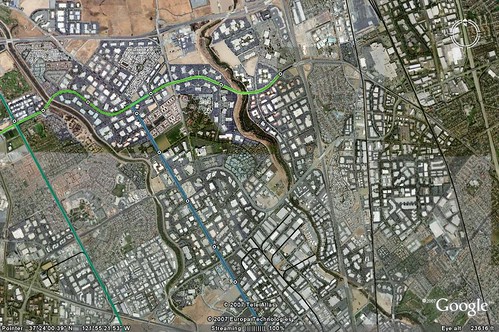Tuesday, November 4, 2008
Transit Election Results Central
Update 2:28 AM PT - So I get in bed and am about to shut my computer down when Measure R jumps to 97% complete! 67.3% looks great!
Update 2:04 AM PT - I have a flight to NC in the morning so I'm packing it in. Currently HSR is leading by a good amount and Measure R looks like it might pass as well. Hawaii looks good but I don't know where those missing precincts are and if they are pro-Mufi/pro-Rail. Measure B is a tough sell though. All in all it was a good night for transit. As I said earlier, Missouri was the only loser out of all of them. And when I get back, I'll put Seattle back on the Space Race list.
Update 1:42 AM PT - It looks like Missouri is just anti-transit. Everywhere else "won" even if they didn't win. ie: 66% is a really annoying threshold.
Update 1:32 AM PT - Measure R and HSR are looking good. The BART measure is really close teetering over and under the 66% it needs.
Update 12:53 AM PT - It's a pretty safe bet to say that KK (Requiring a vote to take away car lanes for transit) went down in flames while VV (AC Transit Parcel Tax) passed with a wide margin of error. The complete results are not in yet, but its probably fair to say it passed.
Update 12:42 AM PT - Sonoma Marin seems to have passed their commuter rail line. With three precincts left, it's at 69% which means its likely to pass the 66% mark.
Update 12:36 AM PT - It looks as if the transit tax passed in all New Mexico Counties. Rail Runner and possibly a streetcar in Albuquerque.
Update 12:23 AM PT - HSR is going strong at 52% With 61% reporting
Update 11:48 PM PT - Honolulu up almost 53% with 76% in
Update 11:46 PM PT - Aspen Returns are in. Yes for BRT There.
Update 11:31 PM PT - All of the returns are in for Marin so we'll have to wait for Sonoma. They both have to total 66%. Marin is 63% currently and Sonoma is 73%. HSR is really close at 52% For.
Update 11:02 PM PT - It's official, no Space Race Expansion for St. Louis. Measure M goes down by 51- 49. A close race for sure.
Update 10:38 PM PT - It looks like Light Rail in Seattle will pass and Streetcars have passed in West Sacramento. High Speed Rail is in a tight race and AC Transit looks to raise a parcel tax while KK, the anti-BRT measure looks like its getting shot down.
Update 10:17 PM PT - Looks like Milwaukee has a new source of money for transit. The electricity in the streets here is amazing as I just walked down Valencia street and cars were honking horns and people were biking and yelling on the street.
Update 9:52 PM PT - It looks good in New Mexico. We might see more Commuter Rail and a Streetcar there soon.
Update 9:04 PM PT - Prop 1 in Seattle Looks good so far.
Update 8:20 PM PT - We're starting to see West Coast Measures. Coming fast and Furious.
Update 7:57 PM PT - Missouri measures are looking bad.
Update 7:25 PM PT - It's good for Obama but rough out there for the transit measures. All are hovering around 50%. I don't know what parts of the counties these are in but New Mexico looks strong.
Update 6:47 PM PT - Starting to come in but slowly.
Update 5:41 PM PT - Results are going to be slow since we're working mostly on the West Coast. Wisconsin and St. Louis will probably be some of the first results we get so I'm keeping closer tabs on those.
Wheeee!!! Here we go...
Breakin it down below:
~~~~~~~~~~~~~~~~~
St. Louis Proposition M - A half cent sales tax for Metrolink Operations and Expansion Results Below (LOSS)
Update 1: 3:43 PT - No Results Up Yet
Update 2: 50.2% No (1% in)
Update 3: 51% No (16% in)
Update 4: 52% No (44% in)
Update 5: 52% No (86% in)
Update 6: 51% No (93% in)
Update 7: Measure M Lost 51% No
~~~~~~~~~~~~~~~~~
Kansas City - Question 1 Light Rail (LOSS)
A 3/8 cent sales tax to build and operate a starter light rail line.
Update 1: 4:46 PM PT - No Results Yet
Update 2: 6:41 PM PT - 59% No 0% In
Update 3: 7:27 PM PT - 54% No (40% in)
Update 4: 7:49 PM PT - 56% No (84% in)
Update 5: 8:02 PM PT - 56% No (96.7%)
Update 6: 8:47 PM PT - 57% No (97%)
It looks like Kansas City burned its chance for light rail. A shame really.
~~~~~~~~~~~~~~~~~
Milwaukee Wisconsin - Sales Tax Increase (WIN)
A ballot measure that would increase the sales tax by a half cent to pay for transit service among other services.
Update: 4:55 PM PT - No Results Yet
Update 2: 6:43 PM PT - 53% No (1% in)
Update 3: 7:10 PM PT - 52% No (2% in)
Update 4: 7:21 PM PT - 50.1% Yes (3%)
Update 5: 7:34 PM PT - 54% Yes (19%)
Update 6: 7:52 PM PT - 54% Yes (38%)
Update 7: 8:04 PM PT - 54% Yes (42%)
Update 8: 8:49 PM PT - 53% Yes (71%)
Update 9: 9:07 PM PT - 53% Yes (76%)
Update 10: 9:33 PM PT - 53% Yes (86%)
Update 11: 10:17 PM PT - 52% Yes (94%)
It looks like we can probably put this one to bed.
~~~~~~~~~~~~~~~~~
Santa Fe/Albuquerque - A quarter cent sales tax to bring Rail Runner into Santa Fe from Albuquerque and provide transport funding for local agencies. The Abq Streetcar could get a jump start from this source. (WIN)
4 Counties of Results
Valencia | Bernalillo | Sandoval | Santa Fe
Update 1: 3:44 PT - No Results Up Yet
Update 2: 7:15 PT - 52.9% For (Bernalillo County Absentee Only)
54 % For (Sandoval County Absentee Only)
Update 3: Valencia County 62% For (Unknown)
Update 4: 9:45 PT Bernalillo up to 53.5% For with 66% or so in
Santa Fe 52.7% For
Valencia County 61% For
All counties have come in for the Transit Tax.
~~~~~~~~~~~~~~~~~
CALIFORNIA SUBSET
From North to South
West Sacramento - Measure U Streetcar (WIN)
A half cent transportation sales tax that would in part pay for streetcar service across the river to the city.
Update 1: 5:15 PM PT - No Results Up Yet
Update 2: 8:24 PM PT - 63% Yes (0% in)
It looks like this has passed.
Sonoma Marin - SMART Rail (WIN)
Would build and operate a commuter rail line from Larkspur North. MUST HAVE 66% in the counties combined. Last time it just barely missed passing.
Update1: 4:22 PM PT - No Results Up Yet
Update 2: 10:22 PM PT - Marin 62% For (67% in) Needs 66% to pass
Sonoma 70% For (40% in) Needs 66% to pass
Update 3: 10:51 PM PT - Marin 62% For (97% in)
Update 4: 11:14 PM PT - Sonoma 73% For (52% in)
Update 5: 11:28 PM PT - Marin 63% For (100%) This means that Sonoma needs to bring it up to 66%. It looks like it might be able to.
Update 6: 11:51 PM PT - Sonoma 73% (68% in)
Update 7: 12:46 AM PT - Sonoma 73.5% (100% in)
If i'm correct, this adds up to 69% in both counties which means it wins.
Oakland/Berkeley - 2 Measures
Measure VV would give AC Transit a parcel tax increase to fund operations. Measure KK would require a vote to change street priority from cars to HOV, BRT, or other street running motorized dedicated transportation.
Update 1: 4:15 PM PT - No Results Up Yet
Update 2: 8:27 PM PT - 78% No on KK (0% in)
Update 3: 8:28 PM PT - 68% Yes on VV (o% in)
Update 4: 11:23 PM PT - 69% Yes on VV (10% in)
79% No on KK (4% in)
Update 5: 12:09 AM PT - VV 71% Yes (66% in)
KK 76% No (77% in)
At this point we can probably say that KK got shot down while VV passed.
San Jose - Measure B BART to San Jose (MUST HAVE 66% to pass)
An 1/8th cent measure to operate an extension of BART to San Jose.
Update 1: 4:28 PM PT - No Results Up Yet
Update 2: 8:34 PM PT - 65.6% Yes (Partial Results)
Update 3: 11:54 PM PT - 66% (37% in)
Update 4: 12:15 AM PT - 65.7% (46% in)
Californa Full - Prop 1A High Speed Rail
Float $10B in bonds to build High Speed Rail between San Francisco and Los Angeles
Update 1: 4:36 PM PT - No Results Yet
Update 2: 8:32 PM PT - 51% Yes (5% in)
Update 3: 9:37 PM PT - 51% No (14% in)
Update 4: 10:23 PM PT - 51% No (22%)
Update 5: 10:43 PM PT - 51% For (31%)
Update 6: 11:06 PM PT - 51% For (35%)
Update 7: 11:21 PM PT - 51% For (38% in)
Update 8: 11:27 PM PT - 52% For (43% in)
Update 9: 12:05AM PT - 51% For (50% in)
Update 10: 12:21 AM PT - 52% For (58%)
Update 11: 1:20 AM PT - 52% For (70%)
Update 12: 1:34 AM PT - 52% For (75%)
Update 13: 2:04 AM PT - 52% For (83%)
Los Angeles - Measure R (MUST have 66% to pass)
A half cent sales tax that would pay for an expansion of transportation such as light rail and subway.
Update 1: 4:37 PM PT - No Results Yet
Update 2: 8:18 PM PT - 64% Yes (10% in)
Update 3: 10:29 PM PT - 65% Yes (16% in)
Update 4: 10:46 PM PT - 65.9% Yes (23%)
Update 5: 11:06 PM PT - 66.3% Yes (29%)
Update 6: 11:44 PM PT - 66.3% Yes (44%)
Update 7: 12:04 AM PT - 66.5% Yes (51%)
Update 8: 12:50 AM PT - 66.9% Yes (64%)
Update 9: 1:07 AM PT - 67% Yes (70%)
Update 10: 1:25 AM PT - 67.2% Yes (77%)
Update 11: 1:43 AM PT - 67.3% Yes (83%)
Update 12: 2:04 AM PT - 67.3% Yes (90%)
Update 13: 2:28 AM PT - 67.3% Yes (90%)
~~~~~~~~~~~~~~~~~
Honolulu Hawaii - Steel on Steel Rail Election
An election to decide whether to move forward with a steel on steel rail line.
Update 1: 4:44 PM PT - No Results Yet
Update 2: 10:48 PM PT - 52% Yes (28% in)
Update 3: 11:49 PM PT - 52% Yes (76% in)
~~~~~~~~~~~~~~~~~
Seattle - Prop 1 Sound Transit Expansion (WIN)
A ballot measure to increase the sales tax to pay for expanded regional light rail and bus service.
Update 1: 4:49 PM PT - No Results Yet
Update 2: 8:17 PM PT - Snohomish County 55% For (100% In)
Update 3: 10:33 PM PT - Looks like ST2 is passing in all 3 counties. In King by 60%
Update 4: 12:31 AM PT - 58% passing with 335,000 votes cast
~~~~~~~~~~~~~~~~
Aspen - Prop 4A Bus Rapid Transit (WIN)
A ballot measure that would increase the sales tax by a .3% to pay for bus rapid transit expansion.
Update: 5:13 PM PT - No Results Yet
Update: 10:36 PM PT - 52% with 2 districts left to vote
Update: 11:47 PM PT - Prop 4A Wins
~~~~~~~~~~~~~~~~
If I'm missing something let me know.
Tuesday, October 21, 2008
TODcasts Available from MTC
Thursday, September 18, 2008
Go PRT!
The proposed system involves a 100 percent fare box cost recovery. Imagine: no subsidies for operation and maintenance costs.Because why build one to see if it works as advertised when we have computers!
The much-touted San Jose light (sic) rail recovers just 10 percent of its O & M costs. A.C. Transit recovers just 30 percent. BART recovers so little, it survives on a $250 million annual subsidy.The CyberTran System, already off the design boards and proven feasible in numerous computer simulations, is ultra-light and involves no grade crossings. Instead, the few intersections encountered are all safely grade-separated. Why? Speed and safety.
Thursday, July 24, 2008
And So It Begins...
Sunday, July 6, 2008
Been Thinking About Transit Density Part 2
For San Francisco, Eric and others have looked at what a city wide metro would look like. However I thought it would be good to look at it from the standpoint of the sphere I created for the Oakland Map. These aerials are the same dimensions as the Oakland map as are the 5 mile spheres. In the fine grid of San Francisco, you can see that a metro as envisioned below would create a tic tac toe board where getting from destinations all over the densest parts of the city would be fairly easy.

For San Jose though I took a different approach. Instead of using downtown as the center, like Oakland, I thought about how a metro could be used to reconfigure the city and employment districts of Silicon Valley. What came out of it was a more northern sphere centered around west of the airport where there is a lot of land and buildings that could be rebuilt now that their 20-30 year life might be almost over.
It was hard to not try and cover everything instead of focusing on the sphere. These city sphere metro projects could be pretty inexpensive when compared to their resulting benefit which is why its important to think about the area in much smaller terms and corridors.
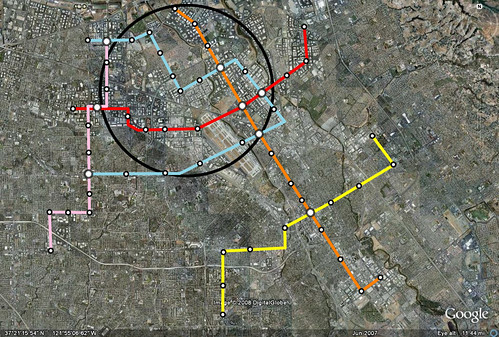
In San Jose in particular, it grew up in such a spread out pattern, that serving the area, unlike Oakland and San Francisco, would be even more daunting. But its possible to use this metro as a starting point to comprehensive feeder bus and commuter rail system that connects the major cities.
Below is an example of this exercise at build out in Austin at the same scale.
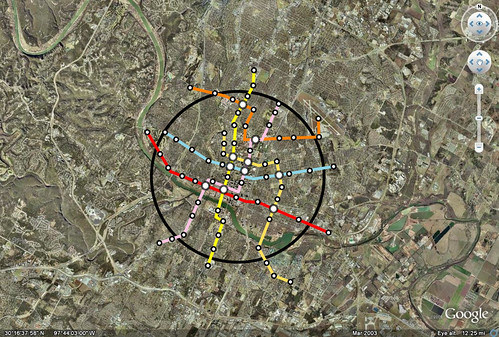
So the point of this exercise isn't to say that these networks should be built with these specific lines, but to show transit density in a core area that would promote the usage of transit in the core while also starting to change the development paradigm. If this type of service were available, walkable neighborhoods would be constructed that have more opportunities to go carless. These networks could also be used as a basis for bike planning.
Wednesday, July 2, 2008
Been Thinking About Transit Density Part 1
Some thoughts before I read it though based on what I've read in Richard's posts and my own evolution in thinking.
I had a bit of a thought today that should have come together sooner but I was looking over Google Earth at a way to connect commuter rail/HSR directly to downtown San Jose instead of the current just outside of downtown location of Diridon station. It seems to me that what is needed in each city around the bay is a local metro that moves people quickly around the central city. Each of these metros can be connected by commuter rail lines like Caltrain along commuter corridors but the most beneficial systems will be those that serve future density, not just existing transit.
I started writing this post before going to Washington with the hope that on the plane I could make some maps. The good part is that the trip reaffirmed what I wanted to back up. That an in town metro is important to vibrancy and movement in a city. Serving the suburbs should be done, but the way we are going to make our transit systems work is with good circulation in the center to build up core density. If we could see where Washington DC was before Metro and where it is now, you would see a huge difference in the city. If the current naysayers were around then to kill projects, that project would have never been built, and the city would look very different.
But other cities should look to the future in the same way. The future benefits outweigh current costs and with more people preferring to live a city life, its got an increased benefit of soaking up growth that would usually cause gross distortions in where people live and work. This is the option of urbanism like Chris Leinberger says.
So we'll start at Oakland. Previously I made a fantasy map for an Oakland Metro that you see directly below.
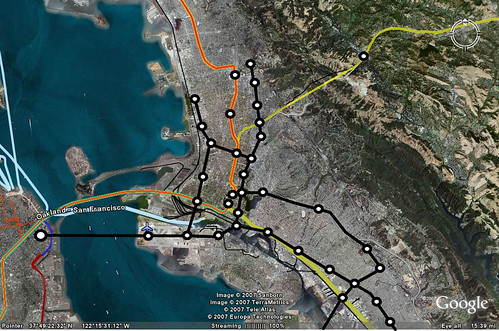
This was based on getting people in and out of a city, and not really a core urban strategy. I realize that now, but when you compare it some of the Subway systems that work really well it doesn't really look quite right.
Vienna's Metro looks different. There are a number of lines that criss cross a number of ways. The same with the Washington Metro.
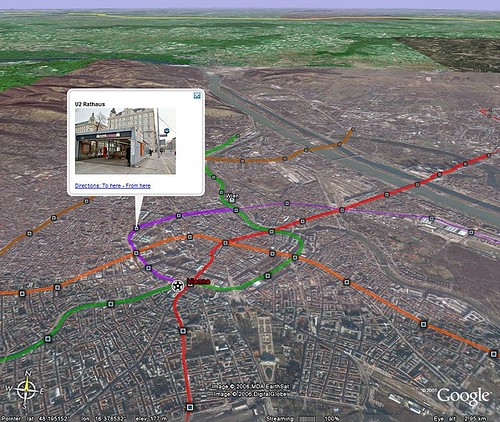
 With that being said, here's a more core system. I've come up with these for San Francisco, Oakland and San Jose as the major regional centers but am thinking about doing other cities as well. The Space Race focuses so much on suburban serving transit that the core again is left out. But perhaps this is the way we should rethink it. We'll start with Oakland.
With that being said, here's a more core system. I've come up with these for San Francisco, Oakland and San Jose as the major regional centers but am thinking about doing other cities as well. The Space Race focuses so much on suburban serving transit that the core again is left out. But perhaps this is the way we should rethink it. We'll start with Oakland.
Now all of these maps will be at the same scale for the Bay Area. The circles are about 5 miles across and show a primary core that could densify in corridors and the core soaking up a lot of housing need and with less energy usage from density, walkable neighborhoods, and easier access to close districts.
Now I'm not sure that this necessarily needs to be a Metro Subway. It could be a dedicated lane streetcar or light rail. However a subway can go from end to end without having to stop at a light and stay on schedule with faster speeds. This facilitates use. But it might work in a smaller city with a smaller sphere than the five miles for core circulation. We should think about these implications and ask, what will get us the most riders and most future benefit instead of just thinking about cost and as I've mentioned before just bringing people into the center of the city.
Tuesday, June 24, 2008
Using Space Better Comments
That looks like the lettered part of the Cisco campus (or at least the area near it - lettered buildings are west of 1st, numbered buildings are east). I worked in building 6 (or was it 7) for a few years. While that particular building was at the Cisco Way station, getting around campus without a car was terrible. An example - people would *drive* to get across the street to building 10. Why? Because you can only cross (safely) at the corners and the blocks are very long.Wow. Not just bad to get there, but bad to work there too. Thanks for the comment Marc. And welcome to all those who found their way here from Blogs of Note.
Tasman is also very wide (5 lanes in each direction, if you include the turn lanes), plus enough width for three tracks of lightrail. If you're going from a midblock building to the midblock building across the street, you're looking at a 10-15 minute walk.
Sunday, June 22, 2008
Arlington Did It Right
It got me thinking, what would BART look like if they had made the decision to build like Metro in DC and run the line through main corridors instead of down the center of the freeway. Here is what I came up with. The dotted lines and black dots I drew and the regular line and existing stations are shown by the little BART symbols.
If I were to speculate that these stations would have the ridership of 24th and 16th street mission, we would be seeing an additional 110,000 riders.
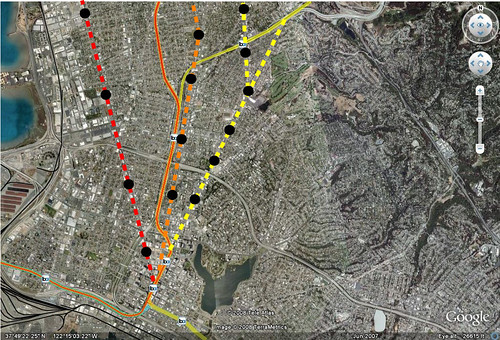
Since BART didn't learn anything from Arlington either, the BART to San Jose line will make the same mistakes, running on existing ROW instead of down the main corridors where its needed. The same exists with the BART to Livermore extension which we discussed earlier.
Thursday, June 5, 2008
Not that Simple
I worry about analysis like these in the Tyee. While it's nice to think that if we didn't build that heavy rail line we could build x more miles of streetcar lines, it's really not that simple. Mostly because they serve two different purposes. You can't just say we can have 8 miles of streetcar for a mile of heavy rail, because what is happening is your trading short trips at a slower speed for longer trips at a faster speed. It's necessary to have both.
This morning I was listening to forum on KQED and one of the callers said it was absurd that he couldn't get from Sunnyvale to Berkeley in 2 hours. This is due to the lack of express trains between major destinations. In a better transit system, you would have Caltrain bullets stopping only at places like San Jose, Palo Alto, and San Francisco. Then it would go in it's own tube to Oakland and Berkeley. This is an expensive service due to the tube and electrification etc, and would likely generate calls to spend money more "cost effectively". They would say, why not build 400 buses or the next big trade off. The problem is you need both. In order to make transit useful, there need to be short trips and long trips made easy.
Now I know there is limited funding, but we need to start thinking like non-transit wonks think. And they think, why can't I get from a to b in under an hour if it takes that long in my car. Transit has to be competitive time wise, whether you're trying to hop a few blocks to get a bite to eat or going to a different city in the region.
Saturday, May 31, 2008
Who Knew Part 2: Buy Poor People Cars
Wendell and other able bodied people don't really care about kids or older folks that can't drive. Those dial a ride programs are expensive and aren't very reliable. Imagine how much more expensive they would be if they were flushed with all the new traffic after bus routes were shut down. Basically buy people cars and provide taxis. Real good idea Wendell. Lets not get into "the math" either. You always forget to add in the taxpayer cost of local streets, health implications of higher pollution, cost of parking spaces, loss of property tax from highways not to mention the massive taxpayer cost of highway expansion that would have to take place to accommodate all those new cars you bought people.Q: What would you do if you got to run the Port Authority?
A: If I were given dictatorial powers to go into a place like Pittsburgh and not have to deal with the feds and everything, I would propose that what we do is first offer a program of leased cars to our low-income riders and basically try to move all of our low-income drivers who can drive to cars. And by the way, the mathematics work very well.
Secondly, I would strengthen dial-a-ride (Access) programs to help those people we can't help with cars. And thirdly, I would provide whatever service can be provided by bus or rail profitably. That means that people who work downtown are going to have to start paying their share. Maybe that hurts downtown. But the fact is, there's no reason why a downtown employee should not be paying the full cost of his transit ride to downtown.
There are a lot more gems of half truths and bs in this column, but I thought I would share more. I think its safe to say that Wendell just hates transit and loves cars. He loves the way of life that costs most Americans 19% of their income right off the bat.
Q: What's the best transit system in the United States -- or is there one?
A: Boy.... Oh, San Diego. I would not call it the best. I'd call it the least worst. San Diego has done some wonderful things. They started contracting out transit service in 1979. Their costs are much lower than other systems as a result. More than 40 percent of their system is contracted out now. They carry a huge increase in ridership compared to what they had in 1980 -- a ridership increase that's far greater than the population increase. Everybody likes to talk about the San Diego Trolley, the light rail line. It is, again, the least worst trolley in the country. It is less unsuccessful as a result of its first line that went to the Mexican border. For example, if those Port Authority tunnels under the Allegheny River in Pittsburgh were ending up at the Mexican border, they might make some sense. But in the early years, this San Diego line covered 90 percent of its operating cost; it never covered any capital. As the system has expanded, it's been decimated. There's no other destination like the Mexican border. When you talk about transit in the United States, you have to be talking about best prisoner awards. These systems are a scourge on taxpayers. There are some that do some wonderful things, but nobody does it all right.
There's a bit of race baiting in here mixed with some good ole misleading information. Nothing new from people like Wendell. First off, the San Diego Trolley is the most efficient light rail system in the United States. It operates at 20 cents per passenger mile. Give any other mode outside of bicycles and walking that operate at that low cost. This is saving taxpayers money. Don't give me this bs Wendell about decimation. Your twisted logic has led the United States into this mess we are in today with people dependent on the oil god. Consume all you want and pay later. Well that bill is going to come due soon and the tax payers are going to front it. That will be decimation. It would have been better off in the long run if you and your ilk weren't so busy promoting wasteful living arrangements and solutions that would create more carbon expulsion.
It also seems like Wendell also has a hate for downtowns. I'm not sure why. Perhaps he believes that people should be isolated from each other and knowledge agglomeration should be limited. It's funny to think that Randall and Wendell attack San Jose for its planning, when in reality its much of their thinking that has gone into what created that place. More roads, less downtown, more driving.
We'll get to those privatization arguments later when we have more time.
Tuesday, May 27, 2008
Mayor Funk Releases KC Transit Plan
Much of the express bus mileage seems to be on freeways which won't affect or change development paradigms in the region and the light rail seems cut short. I don't quite understand the streetcar either. Is it supposed to be a loop? Is it only a feeder? Where is the central city circulation? The commuter rail looks good though, connecting what looks like a few job centers from the road patterns. I'm sure KC Light Rail will have more. But for the moment, it doesn't make a lot of sense to me from an outsiders perspective. Anyone else have some insight on this one?

Saturday, May 3, 2008
Using Space Better
1. The Sprawl Way - What San Jose Looks Like

2. Sprawl Rearranged - What the same amount of development would look Like if the development were organized around the station. I outlined the buildings and rearranged them in a more compact way.
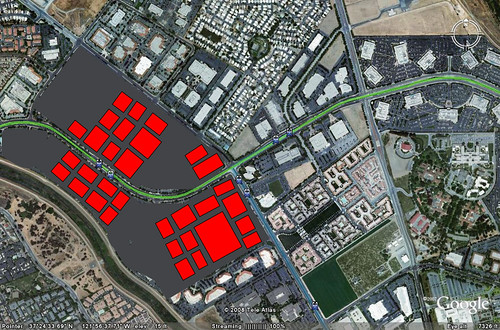
3. Sprawl Rearranged x2 - Doubling the amount of buildings, using the same footprint for each original building.

Friday, May 2, 2008
Kenworthy Speaks
1. LRT(Tram) Patronage in Europe has been increasing while bus ridership falls.
This is interesting to me because unlike the United States, Europe has kept a good amount of its tram systems. In many large cities, they are still networked to go a lot of places.
According to Jeff, in Europe, over a period of 10 years, Light Rail Transit (LRT) patronage rose 20.3% while bus patronage fell 5.6%. His implication is that people, the masses, simply and unequivocally prefer rail over bus. And surprisingly, it’s actually what are commonly considered the disadvantages of rail that turn out to be it’s advantages over bus transit in encouraging use. The high cost and inflexibility of rail creates a permanence that people prefer over the impermanent and unreliable nature of bus transit.2. Rail Focuses Development, Buses Follow it
Another polished gem Jeff provided us with was the idea that rail systems “focus” a city and development while bus systems simply “follow” development. So buses, because of their impermanence and reliance on auto roads, must heed to the “predict and provide” game and attempt to follow wherever development may randomly occur. Rail on the other hand spurs and centralizes development, creating a sense of permanence not found in no rail cities. Rail and streets renaissances go hand in hand.I've said this a few times before. Rail has the power if harnessed to focus development unlike buses that just respond to it. But it's not going to just happen. There need to be plans and policies in place to do it right. In the comments below Fred's post, a discussion started on San Jose. This is the perfect example of just saying that light rail is going to do all the work. I posted a while ago on employment sprawl. Well here again is an aerial of San Jose's system by all the tech jobs, something to not emulate.

Here is the Pearl District, which used to be a rail yard and was helped by the plans and policies of the PDC and the streetcar

Update: ABC in the comments asked that we use a more suburban area to show what's possible instead of an urban area. In the situation like San Jose above with 3 -5 story office buildings I think it's perfectly ok to expect a street grid like the Pearl Districts, there was a thought that it was the Pearl was predestined to turn out that way. Before the development agreement it was supposed to be tops 15 units an acre and the developer had thought about doing townhomes. Here is what it looked like in 1996.
 But as suburban examples go, here is another from Portland with single family homes in a grid South of Orenco Station.
But as suburban examples go, here is another from Portland with single family homes in a grid South of Orenco Station.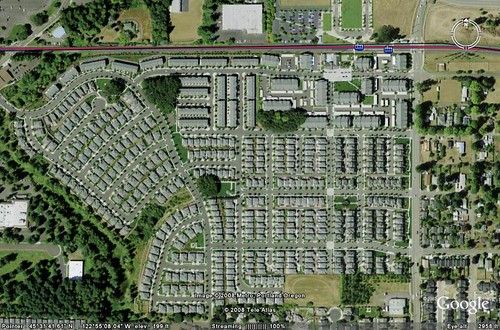
Downtown Plano trying to reintroduce Urbanism
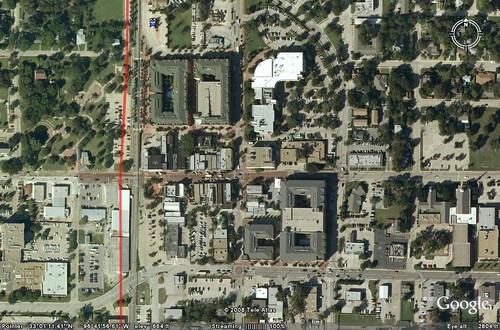
And a Heavy Rail Subway example, Rosslyn Ballston on the Metro Orange Line. I've discussed this before but this used to be a strip suburban corridor. These things take time, this has been over 30 years.

Monday, March 24, 2008
AC on Density #2
Sunday, January 13, 2008
Thinking Big: The Next Bay Area Project
But that isn't what i really wanted to talk about. I have a new idea for the Bay Area's newest New Start/Transit Project. I'd like to call it the Subway to the Sea 2, Urban Core Capacity Enhancement. The title is a nod to the Subway to the Sea bubbling up in LA and the New Jersey Access to the Core tunnel under the Hudson. If we're going to densify the bay area further, we need more of a metro system along major corridors. We need to be cost effective, so we should start with a corridor that would generate a lot of new ridership. So how about we build a line between the beach and downtown on Geary, build the new trans-bay tube that's been planned, and build up Broadway in Oakland to Rockridge and Berkeley under the 51 line.
Current ridership in this corridor is 56,000 for Geary and 18,600 boardings on the 51. This means that if everyone changed modes (which we know there still has to be a surface bus line for shorter trips) there could be about 80,000 riders. Given the speed of the new line and convenience it could increase ridership to way over 100,000 a day just on the line. This is a third of BART's ridership. Now the line is 19 miles from Berkeley to the Sea along the route I mentioned.
Now the line wouldn't just generate a lot of ridership, but it would generate a lot of new TOD, Office and Residential. In Oakland on Broadway, there would be a surge in new development along the corridor between College Avenue and Downtown. It's possible to capture a lot of the office and residential markets and take some pressure off of the outer sprawling suburbs. It will also take pressure off of the almost at capacity Transbay Tube.
Another feature of this would be the tunnel under the bay. it should be designed to be dual mode so that Caltrain/HSR could go to Oakland, Emeryville, and/or Jack London Square. That way Caltrain could extend into downtown and across the bay to Emeryville and possibly beyond making a connection between the jobs there and Silicon Valley (Yellow). It's possible to electrify the line all the way up to Martinez making commutes from around the horn easier with new stations in North Richmond and Hercules. It might also provide a way to keep trains away from Jack London which has had some issues with accidents. It would be a big project and more than likely cost a lot of money, but it will also be a huge ridership generator. Not only will you get over 100,000 from the subway alone, there will be the tens of thousands that want to get across the bay with a one seat ride to Emeryville and Jack London Square.
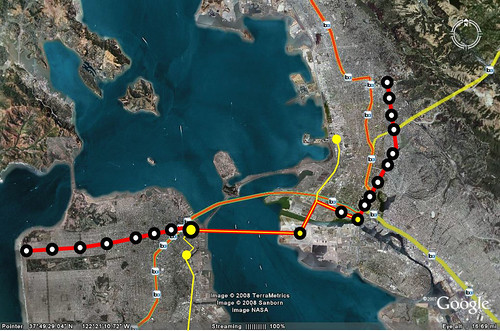
Saturday, November 17, 2007
Creating Demand for Office TOD
Demand for quality space in Google-land is strong, and market rental rates now justify the costs of redeveloping obsolete industrial structures into higher-density modern offices, observes veteran Silicon Valley commercial broker Gregory M. Davies at CPS/Corfac Intl. in Santa Clara.
Planned commercial projects are taking advantage of the neighborhood's attractive transit service, including not only the VTA light-rail system but also Caltrain's Baby Bullet express service whizzing commuters from San Francisco in well under an hour, Davies adds.
This also brings up another point about San Jose. The office park sprawl there with all the tech companies is probably the worst I've ever seen. I don't get why our buddy Randal O'Toole calls San Jose a failure in Smart Growth when there is none. The land use around light rail is the worst in the country and never focused. Just junk buildings that should be destroyed and reoriented towards the streets and given a grid.
Check out the aerial below to see what it looks like. Tons of parking spaces and wasted land. Its amazing this system gets over 30,000 riders a day. The green and blue lines are the San Jose Light Rail. Looks like its going through a bunch of industrial warehouses, but they are just single use offices.

